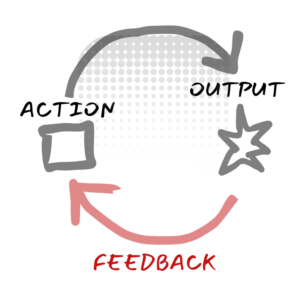Feedback loops are essential for growth, whether you’re solving problems, improving skills, or designing products. Here’s how to apply this concept to everyday life:
What is a Feedback Loop?
A feedback loop is a process of continuous improvement where the results of your actions are used to refine future actions. The three steps are:

- Action: Take an intentional step or make a decision.
- Output: Observe and measure the results (output).
- Feedback: Analyze the outcomes to inform your next move.
This cycle repeats until the desired outcome is achieved.
Why It Works
Feedback loops work because they facilitate iterative improvement. Each cycle brings you closer to your goal. Whether that’s perfecting a design, refining a strategy, or building a skill.
For example, SpaceX uses rapid prototyping and testing to improve their rocket engines. As Elon Musk points out:
“The way I see it, you should always make prototypes of things as quickly and cheaply as possible, and then iterate based on what you learn from them.”
This approach underscores the importance of quick, cost-effective iteration to accelerate progress and innovation.

This image of the Raptor engine’s evolution perfectly illustrates the feedback loop in action. It showcases how each iteration improves by becoming smaller, simpler, cheaper, and more efficient.
Steps to Use Feedback Loops in Life
- Define Your Goal
Start by clarifying what you want to achieve – whether it’s fitness, career growth, or problem-solving. - Take Action
Make an effort, even if it’s imperfect. Don’t let perfectionism stop you from starting. - Track Results
Log outcomes in a notebook, app, or document. For instance, if you’re learning a skill, track what worked and what didn’t. - Analyze Feedback
Reflect on what you’ve logged. Ask:- What went well?
- What didn’t work?
- What can I change?
- Adjust and Repeat
Apply what you’ve learned, refine your approach, and take action again.
Example: Fitness
If you’re working on strength training:
- Action: Try a new workout routine.
- Response: Monitor how your body reacts (strength gains, fatigue, etc.).
- Feedback: Adjust the routine based on performance and recovery.
The Key: Iterate Quickly and Simply
The faster you complete high-quality iterations, the sooner you will see meaningful improvements. Focus on simplicity and intentional efforts that generate valuable improvement. Over time, this approach promotes consistent and meaningful progress in all areas of your life.
Use feedback loops not just as a tool but as a mindset. They’ll guide you toward progress in your work, health, and personal goals.

